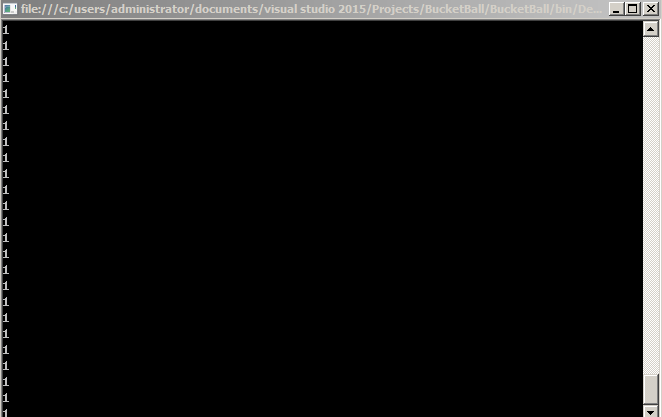《编程之美》284页,问题4.6:桶中取黑白球。
有一个桶,里面有白球、黑球各100个,人们必须按照以下规则把球取出来:
1. 每次从桶中拿两个球;
2. 如果两球同色,再放入一个黑球;
3. 如果两球异色,再放入一个白球;
问:最后桶里面只剩下一个黑球的概率是多少?
于是我开始分析,桶里装球,每次摸球是随机的,所以不能用队列和栈,那就用万能的动态列表来做桶吧。按照题目描述的顺序,写出取球的过程,最后剩的是黑球返回1,白球返回2,其他情况(没球了)返回3,然后根据概率在大数据量下将会趋于稳定的性质无限取球,最后趋于稳定的那个数就是答案。
代码如下(注释的部分为调试程序过程中用到的测试代码,用来显示操作过程中取球、放球、以及桶中球的详细变化过程):
using System; using System.Collections.Generic; using System.Linq; namespace BucketBall { class Program { static void Main(string[] args) { int count = 0; int targetCount = 0; int result; double probability; while (true) { List<string> bucketBalls = new List<string>(); result = Play(bucketBalls); //Console.WriteLine("result:" + result); if (result == 1) { targetCount++; //Console.WriteLine("targetCount:" + targetCount); } count++; //Console.WriteLine("count:" + count); probability = Math.Round((double)1.0 * targetCount / count, 2); Console.WriteLine(probability); //Console.Read(); } }
private static int Play(List<string> bucketBalls) { for (int i = 1; i <= 2; i++) { bucketBalls.Add("BlackBall"); bucketBalls.Add("WhiteBall"); } //PrintList(bucketBalls); Random ran = new Random(); while (bucketBalls.Count() > 1) { var balls = Take(bucketBalls, 2, ran); //Console.WriteLine("Take the balls " + balls[0] + " " + balls[1]); //PrintList(bucketBalls); if (balls[0] == balls[1]) { Put(bucketBalls, "BlackBall"); //Console.WriteLine("Put the BlackBall"); //PrintList(bucketBalls); } else { Put(bucketBalls, "WhiteBall"); //Console.WriteLine("Put WhiteBall over!"); //PrintList(bucketBalls); } //Console.WriteLine(bucketBalls.Count()); } if (bucketBalls.Count() == 1) { //Console.WriteLine("result is " + bucketBalls[0]); return bucketBalls[0] == "BlackBall" ? 1 : 2; } else { return 0; } } private static void PrintList(List<string> bucketBalls) { Console.WriteLine(); foreach (var ball in bucketBalls) { Console.Write(ball + " "); } Console.WriteLine(); } private static void Put(List<string> bucketBalls, string v) { bucketBalls.Add(v); } private static List<string> Take(List<string> bucketBalls, int v, Random ran) { List<string> balls = new List<string>(); int pos; for (int i = 1; i <= v; i++) { pos = ran.Next(0, bucketBalls.Count()); balls.Add(bucketBalls[pos]); bucketBalls.RemoveAt(pos); } return balls; } } }
我因为不小心将一处的“WhiteBall”写成了“WhileBall”而一度修改却得不到正确的答案,最终一步一步的通过上面的测试代码,才将出错范围最终锁定在了初始化bucketBalls的for循环内,最终发现我将“WhiteBall”写成了“WhileBall”。改过来以后,运行结果终于正确了。下面是去掉测试代码的最终版:
using System; using System.Collections.Generic; using System.Linq; namespace BucketBall { class Program { static void Main(string[] args) { int count = 0; int targetCount = 0; int result; double probability; while (true) { List<string> bucketBalls = new List<string>(); result = Play(bucketBalls); if (result == 1) { targetCount++; } count++; probability = Math.Round((double)1.0 * targetCount / count, 2); Console.WriteLine(probability); } }
private static int Play(List<string> bucketBalls) { for (int i = 1; i <= 100; i++) { bucketBalls.Add("BlackBall"); bucketBalls.Add("WhiteBall"); } Random ran = new Random(); while (bucketBalls.Count() > 1) { var balls = Take(bucketBalls, 2, ran); if (balls[0] == balls[1]) { Put(bucketBalls, "BlackBall"); } else { Put(bucketBalls, "WhiteBall"); } } if (bucketBalls.Count() == 1) { return bucketBalls[0] == "BlackBall" ? 1 : 2; } else { return 0; } }
private static void Put(List<string> bucketBalls, string v) { bucketBalls.Add(v); } private static List<string> Take(List<string> bucketBalls, int v, Random ran) { List<string> balls = new List<string>(); int pos; for (int i = 1; i <= v; i++) { pos = ran.Next(0, bucketBalls.Count()); balls.Add(bucketBalls[pos]); bucketBalls.RemoveAt(pos); } return balls; } } }
通过运行结果可以看出来,概率一直很稳定,为1:

所以答案是在白球和黑球各100个的前提下取球放球,最后都只剩下黑球,概率为1。
修改程序中的初始化参数还可以用来求解课后题中的拓展情况,不用动脑。大家可以试试。
总结过程中遇到的问题:
1、字符串赋值的时候一定要仔细,别写错了!
2、Random.Next()函数返回值的范围包括 minValue 但不包括 maxValue。如果 minValue 等于 maxValue,则返回 minValue。